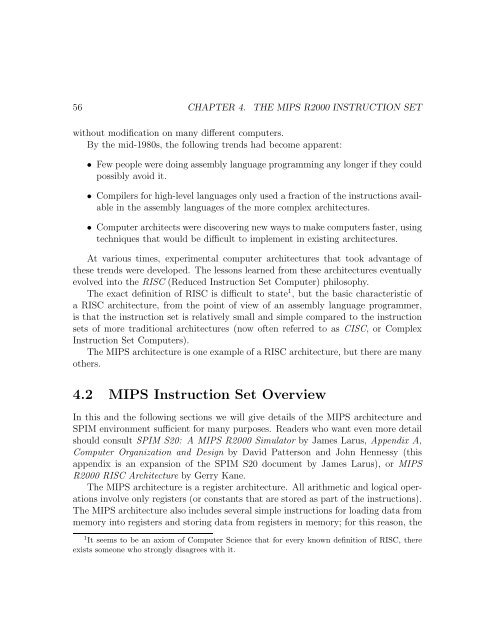MIPS Assembly Language Programming
MIPS Assembly Language Programming
MIPS Assembly Language Programming
Create successful ePaper yourself
Turn your PDF publications into a flip-book with our unique Google optimized e-Paper software.
56 CHAPTER 4. THE <strong>MIPS</strong> R2000 INSTRUCTION SET<br />
without modification on many different computers.<br />
By the mid-1980s, the following trends had become apparent:<br />
• Few people were doing assembly language programming any longer if they could<br />
possibly avoid it.<br />
• Compilers for high-level languages only used a fraction of the instructions available<br />
in the assembly languages of the more complex architectures.<br />
• Computer architects were discovering new ways to make computers faster, using<br />
techniques that would be difficult to implement in existing architectures.<br />
At various times, experimental computer architectures that took advantage of<br />
these trends were developed. The lessons learned from these architectures eventually<br />
evolved into the RISC (Reduced Instruction Set Computer) philosophy.<br />
The exact definition of RISC is difficult to state 1 , but the basic characteristic of<br />
a RISC architecture, from the point of view of an assembly language programmer,<br />
is that the instruction set is relatively small and simple compared to the instruction<br />
sets of more traditional architectures (now often referred to as CISC, or Complex<br />
Instruction Set Computers).<br />
The <strong>MIPS</strong> architecture is one example of a RISC architecture, but there are many<br />
others.<br />
4.2 <strong>MIPS</strong> Instruction Set Overview<br />
In this and the following sections we will give details of the <strong>MIPS</strong> architecture and<br />
SPIM environment sufficient for many purposes. Readers who want even more detail<br />
should consult SPIM S20: A <strong>MIPS</strong> R2000 Simulator by James Larus, Appendix A,<br />
Computer Organization and Design by David Patterson and John Hennessy (this<br />
appendix is an expansion of the SPIM S20 document by James Larus), or <strong>MIPS</strong><br />
R2000 RISC Architecture by Gerry Kane.<br />
The <strong>MIPS</strong> architecture is a register architecture. All arithmetic and logical operations<br />
involve only registers (or constants that are stored as part of the instructions).<br />
The <strong>MIPS</strong> architecture also includes several simple instructions for loading data from<br />
memory into registers and storing data from registers in memory; for this reason, the<br />
1 It seems to be an axiom of Computer Science that for every known definition of RISC, there<br />
exists someone who strongly disagrees with it.

















